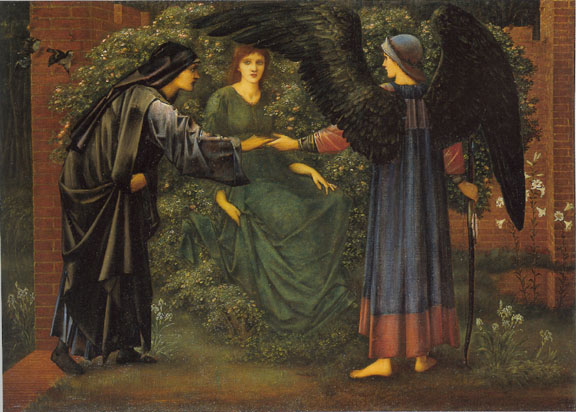
'The ending ofthe tale ye see;
The Lover draws anigh the tree,
And takes the branch, and takes the rose,
That love and he so dearly chose.'
— William Morris
The Heart of the Rose by Sir Edward Coley Burne-Jones, Bt ARA (1833-1898). Signed with initials and dated 1889. Oil on canvas:38 x 51 1/2 inches, 96.5 x 131 centimetres (In original tabernacle frame).
Provenance: William Connal, 23 Berkeley Square, by 1898 (probably bought from the artist); his sale Christie's, March 14 1908, number 35; bought by Sampson for £525; The Maharajah of Jamnegar to 1980; Private collection
Commentary by Bill Waters
This painting and its companion, The Pilgrim at the Gate of Idleness, together with the larger painting, Love Leading the Pilgrim (Tate Gallery), form a trilogy on a romantic theme loosely based on parts of Chaucer's poem Rumaunt of the Rose. Around 1872 Burne-jones and William Morris collaborated on designs for a wall-hanging inspired by the poem, with Burne-jones supplying the figures and Morris the briar background. The narrative sequence, consisting of many scenes, was embroidered by the wife and daughter of Sir Lowthian Bell, Ist Bt, an industrialist, and hung as a frieze in the dining room of his newly-built house, Rounton Grange. Rounton Grange, North Allerton, North Yorkshire was designed by Burne-jones's friend Philip Webb, built in 1872 and is now unfortunately demolished although the stables and some cottages survive. The embroideries, which date from 1874-1882, are now in The William Morris Museum, Walthamstow. Both the present painting, dated 1889, and its companion, dated 1884, are based on the artist's original designs for the wall-hanging. The Museum's collection also includes a chalk drawing of The Heart of the Rose, which is almost identical in size and composition to the painting.
The theme of the Romaunt of the Rose occupied Burne-Jones intermittently for over twenty years. The present painting was begun in 1889 and created as a pendant to the earlier Pilgrim at the Gate of Idleness. Both paintings remained in the studio and were taken up again by the artist in 1892, following a period of illness, and completed in time for the New Gallery exhibition in 1893. Love Leading the Pilgrim (Tate Gallery), the largest ofthe group, was begun in 1877 and finally completed in 1897, the date of its exhibition at the New Gallery.
The three paintings are conceived as a sequence. The first is The Pilgrim at the Gate of Idleness, in which the Pilgrim meets Idleness personified as a beguiling maid. Having escaped that temptation, the Pilgrim is led by Love through a briar thicket, depicted in the Tate Gallery painting. The final scene is represented in the present painting, The Heart of the Rose, where a winged figure, perhaps Love, leads the Pilgrim to the Rose, personified as a beautiful woman within a rose bush.
A large drawing with a composition related to the present painting and also entitled The Heart of the Rose is in the Museum of Fine Arts, Boston. A solitary figure on the left, similar to the Pilgrim, touches the edge of a gigantic rose, at the centre of which is a woman's race in profile. The drawing appears to be a tapestry design for William Morris's craft works at Merton Abbey. Two versions of the tapestry were made, c. 1901; one in a private collection was exhibited in the Burne-jones exhibition at the Hayward Gallery, London, 1975-6, no.23 1, and the other, sold at Sotheby's, London, 7 June 1972, is now in the Museum at Karlsruhe.
William Connal was the first owner of the two paintings, The Pilgrim at the Gate of Idleness and The Heart of the Rose, and probably acquired them from the artist. Connal's sale at Christie's in 1908, occasioned by his move from London to Glasgow, shows him to have been a serious patron of the Pre-Raphaelites. In addition to the nine works by Burne-jones, he sold many other Pre-Raphaelite paintings, notably The Pretty Baa-Lambs by Ford Madox Brown (Birmingham City Art Gallery).
Peter Nahum Ltd, London has most generously given its permission to use in the Victorian Web information, images, and text from its catalogues, and this generosity has led to the creation of hundreds of the site's most valuable documents on painting, drawing, and sculpture. The copyright on text and images from their catalogues remains, of course, with Peter Nahum Ltd.
Readers should consult the website of Peter Nahum at the Leicester Galleries to obtain information about recent exhibitions and to order their catalogues. [GPL]
Bibliography
Waters, Bill. Burne-Jones -- A Quest for Love: Works by Sir Edward Burne-Jones Bt and Related Works by Contemporary Artists. London: Peter Nahum, 1993. Catalogue number 38.
Last modified 5 June 2020